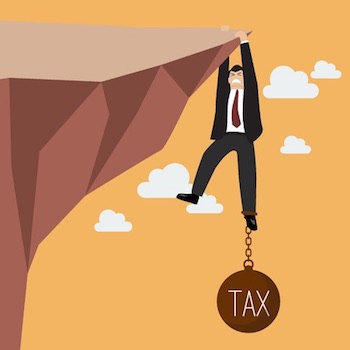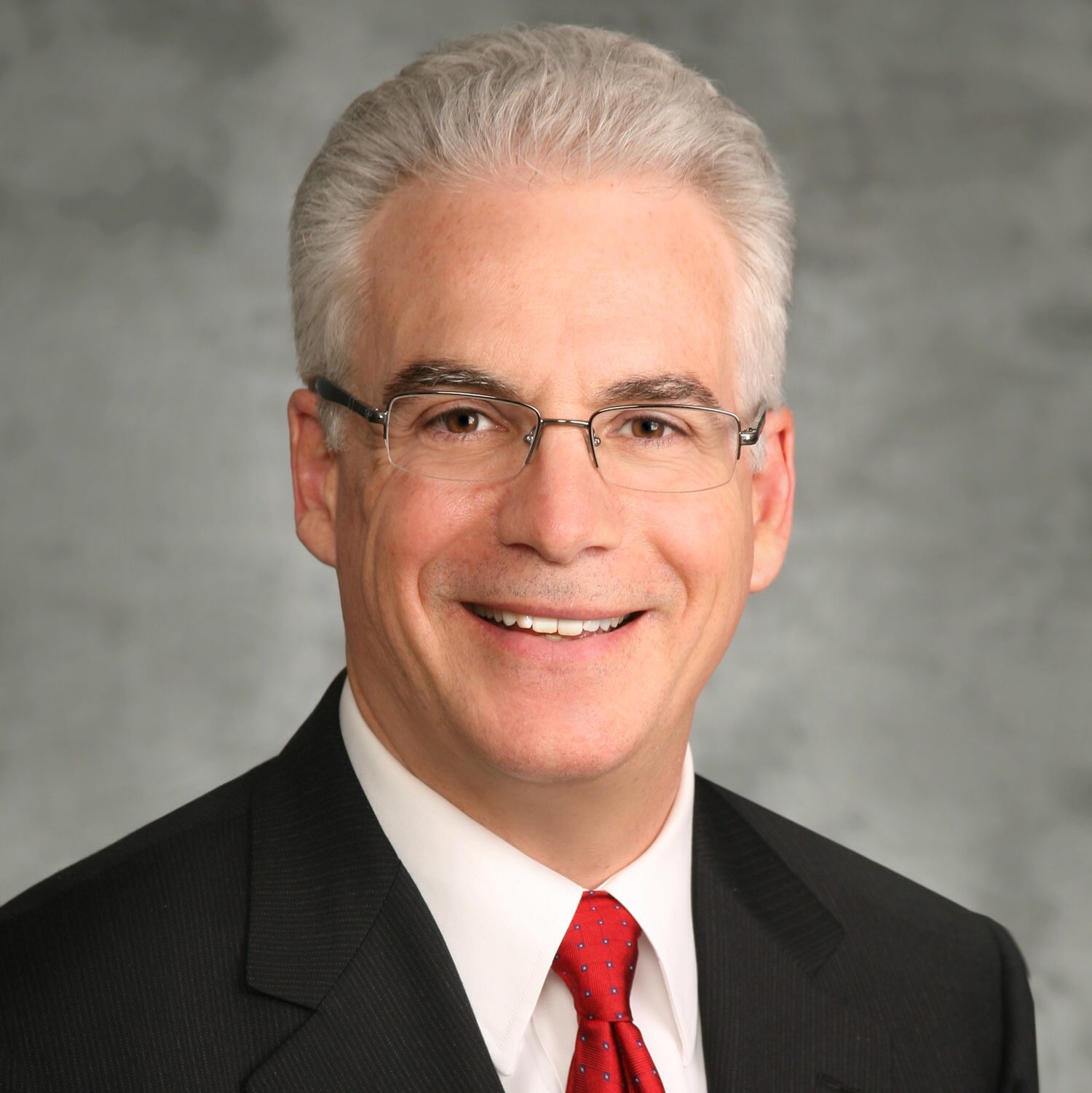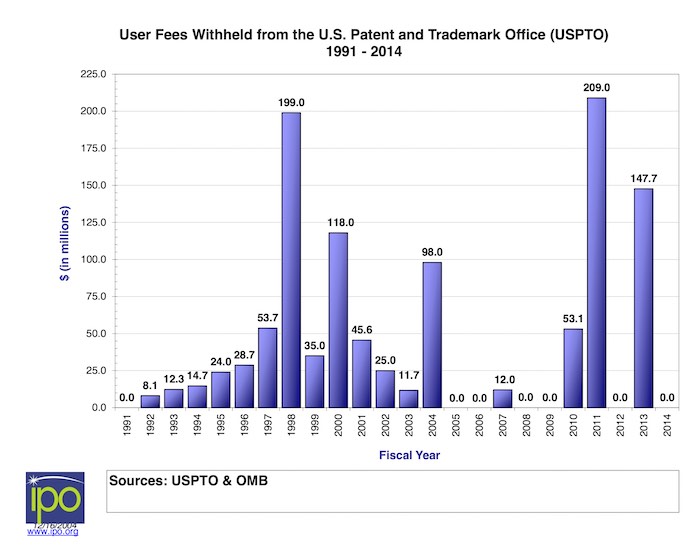 User fees fund our patent system. The patent system turns ideas into assets. Those assets are used to secure financing and gain access to markets. Financing and market access fuel the rise of new industries, businesses, and jobs. Regrettably, however, those user fees are frequently diverted to fund other, unrelated government agencies and programs, which amounts to a tax on innovation.
User fees fund our patent system. The patent system turns ideas into assets. Those assets are used to secure financing and gain access to markets. Financing and market access fuel the rise of new industries, businesses, and jobs. Regrettably, however, those user fees are frequently diverted to fund other, unrelated government agencies and programs, which amounts to a tax on innovation.
The chart below from the Intellectual Property Owners Association (IPO) showing that in just the past five years (2010-2014), a total of $409.8 million in user fees has been diverted from the USPTO. Ironically, the year in which the America Invents Act (AIA) took effect, 2011, saw the greatest sum ever diverted from the USPTO ($209 million). The AIA included measures that were intended to diminish, if not eliminate, fee diversion. It did this by placing “excess” funds (i.e., those collected over budget) in a discrete fund that could be used only by the USPTO. Nonetheless, two years later, $147.7 million in user fees was again diverted from the USPTO.
Despite the best of intentions, the AIA has failed to eliminate the pernicious effects of the existing appropriations process and fee diversion. Even though its “excess” funds are set aside, access and use of those funds remains under the control of Congressional appropriators. Thus, the USPTO lacks discretion in the use of those funds. This undoubtedly impairs the ability of the USPTO to invest strategically in the personnel and equipment needed to improve quality of examination and drive down pendency.
Further, under the current regime, the USPTO is subject to sequestration imposed by the Budget Control Act of 2011. In a 2013 letter to President Obama, the USPTO’s Patent Public Advisory Committee made the following observation:
The fee setting authority provided within the AIA accorded the Office the ability to raise fees by 15 percent and to address the mounting issues in Information Technology and the examining corps. Unfortunately, this was short-lived as the Sequester negated the intended impacts of these new user-generated fees. While we understand that these are the collateral damages associated with the Sequester, we respectfully ask that the Office be allowed to access the fees that it generates, or, at the very least, be provided access to those fees at some point in the very near future.[1]
In combination, the effects of sequestration and the restrictions on access to the “excess” fees fund impair USPTO efficiency and effectiveness. It stands to reason that the USPTO will find it increasingly challenging to maintain its high standards of examination, keep pace with the many changes in the system (including those imposed by the AIA itself), and reduce pendency.
Further, at the August 2015 meeting of the Patent Public Advisory Committee (PPAC), Director Lee announced that the USPTO may be brought into the Department of Commerce Shared Services initiative. That initiative would consolidate certain HR, IT, and procurement functions throughout the Department of Commerce. The IP user community has expressed concern over this initiative. Among other things, it has the potential to subvert the authority of the Director as to the acquisition, selection, and use of crucial resources. This initiative might very well be a further, and hidden, burden on the innovation ecosystem, and a covert tax on those availing themselves of the rights granted by the US Patent and Trademark Office. It is difficult to see how the USPTO can tackle the many challenges before it in terms of patent quality and pendency by decreased, rather than increased, access to critical resources.
The most effective approach to ameliorate those challenges would be to take the USPTO out of the appropriations process, and give it greater access to the funds that users pay into the system. Not only will this free up the USPTO to plan strategically for the long term, it will restore confidence in the user community that the funds being paid into the system are going to support the services that fuel innovation.
The approach found in the STRONG Patents Act (S. 632) to end fee diversion by statute, and to give the Director of the USPTO greater discretion and access to those funds, is a prudent and practical approach that will serve those ends.
________________
[1] Letter from Louis J. Foreman, Chairman, USPTO Patent Public Advisory Committee to President Obama, November 4, 2013 (http://www.uspto.gov/about/advisory/ppac/PPAC_2013_AnnualReport.pdf)
Image Source 123rf.com
Image ID : 43528166
Media Type : Vector Illustration
Copyright : Sira Anamwong

![[IPWatchdog Logo]](https://ipwatchdog.com/wp-content/themes/IPWatchdog%20-%202023/assets/images/temp/logo-small@2x.png)


![[Advertisement]](https://ipwatchdog.com/wp-content/uploads/2024/04/Patent-Litigation-Masters-2024-sidebar-early-bird-ends-Apr-21-last-chance-700x500-1.jpg)

![[Advertisement]](https://ipwatchdog.com/wp-content/uploads/2021/12/WEBINAR-336-x-280-px.png)
![[Advertisement]](https://ipwatchdog.com/wp-content/uploads/2021/12/2021-Patent-Practice-on-Demand-recorded-Feb-2021-336-x-280.jpg)
![[Advertisement]](https://ipwatchdog.com/wp-content/uploads/2021/12/Ad-4-The-Invent-Patent-System™.png)







Join the Discussion
6 comments so far.
Bob Hodges
May 18, 2016 01:34 pmProposed Constitutional Amendment to Abolish Fee Diversion
The Congress, the President, and the Courts shall not have the power to use any part of any fee collected from a member of the public in connection with a defined service provided to that member of the public for a purpose other than the provision of the defined service to that member of the public. The Congress shall have the power to provide, by appropriate legislation, that aggregate fees collected from members of the public in connection with a defined service provided to those members of the public can be used for the general provision of the defined service to those members of the public collectively or in different proportions. This amendment shall not be so construed as to affect the power of the Congress to lay and collect taxes on incomes or to affect the power of the Congress, as established elsewhere and not by this amendment, to appropriate by law money from any source other than fees collected from members of the public in connection with a defined service provided to those members of the public.
staff
May 18, 2016 12:35 pm‘impairs the ability of the USPTO to …drive down pendency’
We agree. Affairs at the PTO are bad enough with management inventors believe is a toady for large infringers and the PPAC chocked full of large multinationals and their puppets. As it now stands large multinationals commonly get their patents in under 3 or even 2 years while inventors have to routinely wait 5 or more. Most of us go out of business before we can get our patents. The system had become a disgrace. Pendency, not quality, is the true issue. AIA and its expedited processing made a mockery of the system. AIA must be repealed and new leadership placed at the head of the PTO which has strong ties to inventors and small entities.
For our position and the changes we advocate to truly reform the patent system, or to join our effort, please visit us at https://aminventorsforjustice.wordpress.com/category/our-position/
or, contact us at [email protected]
Anon
May 17, 2016 12:06 pmI see that you have failed to take my lesson to heart, Mr. Curry.
Your loss.
Stephan Curry
May 17, 2016 10:40 amAnon, this article supports some of my comments I made regarding USPTO fees and upcoming budget challenges in view of AIA and other factors.
You are not busy practicing law too much are you, Anon. You try to be a know it all, but failed to realize a basic principle which is a maintenance fee is effectively a property tax. Professor Crouch previously called it that also.
Inventor0875
May 17, 2016 10:36 amProposed Fee Diversion Solution:
Fee diversion problem occurs because USPTO finances are currently being totaled in the U.S. budget:
In years with surplus applicant fees: the surplus reduces the U.S. budget deficit.
It becomes a one way taking because:
It’s much harder to return earlier year surplus applicant fees back to the USPTO, as politicians appear to be taking money from other valued projects and increasing the U.S. deficit.
Suggested Solution:
Establish a new USPTO independent account that is …. NOT counted in the U.S. budget.
Management of the new independent USPTO account would be overseen by Congress.
Anon
May 17, 2016 07:24 amMr. Curry, this post may help you understand the lesson that I presented to you at https://ipwatchdog.com/2016/05/10/new-patent-office-study-defends-ptab-motion-amend-practice/